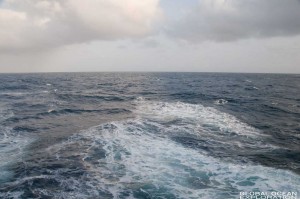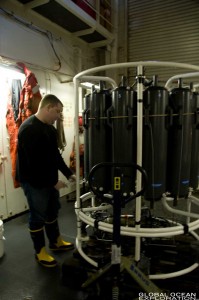Â
Â
It is very early Monday morning here on the Healy and we are finishing up our survey of the 70m isobath and packing up to head to port. Yesterday was filled with finishing up experiments, packing, and getting ready to hit open water. A low pressure system that we have been watching to the south is heading north towards us so that could mean big seas for our transit to Dutch Harbor. Because of the impending weather, much of the packing that would be done today had to be completed yesterday in order for everything to be secured for high seas. I am in the process of packing up all of my cameras, chargers and other gear so that nothing gets damaged if the ship gets tossed about. The Healy is a very smooth riding ship and we are only expecting 15-20 foot swells so it should not be too dramatic. (I hope.) Â
In the meantime, we are doing CTD casts every ten miles to complete our survey of the area. A CTD is a conductivity temperature depth recorder and is the primary tool used by oceanographers to determine the physical parameters of sea water. Sensors on the instrument measure temperature, salinity, and depth while bottles on the rosette structure collect water samples at various depths. This water can then be tested for dissolved oxygen, organic and inorganic carbon, and other nutrients. The CTD gives us information about the physical properties of the water column so that the biology (the animals) can be put into the context of their environment. An invaluable tool, nearly all of the scientists on board sample the water from the CTD and/or use the physical data obtained by the hydro team. We have done 177 casts so far. One has been conducted at every station and along specific survey lines.
  The CTD, Conductivity Temperature Depth Recorder, comes up from 70m where it collected water samples every 10m on its way back to the surface.
Â
Dr. Jeremy Mathis from University of Alaska collects water samples from the CTD. He is looking at ocean acidification in the Arctic region.
Â

John Casey from the Bermuda Institute of Ocean Sciences filters water from a CTD cast. He is looking at carbon ratios in the water. Â
Â
We are scheduled to be finished with science and sampling sometime this evening when we will begin our transit to Dutch Harbor. Â
Â



